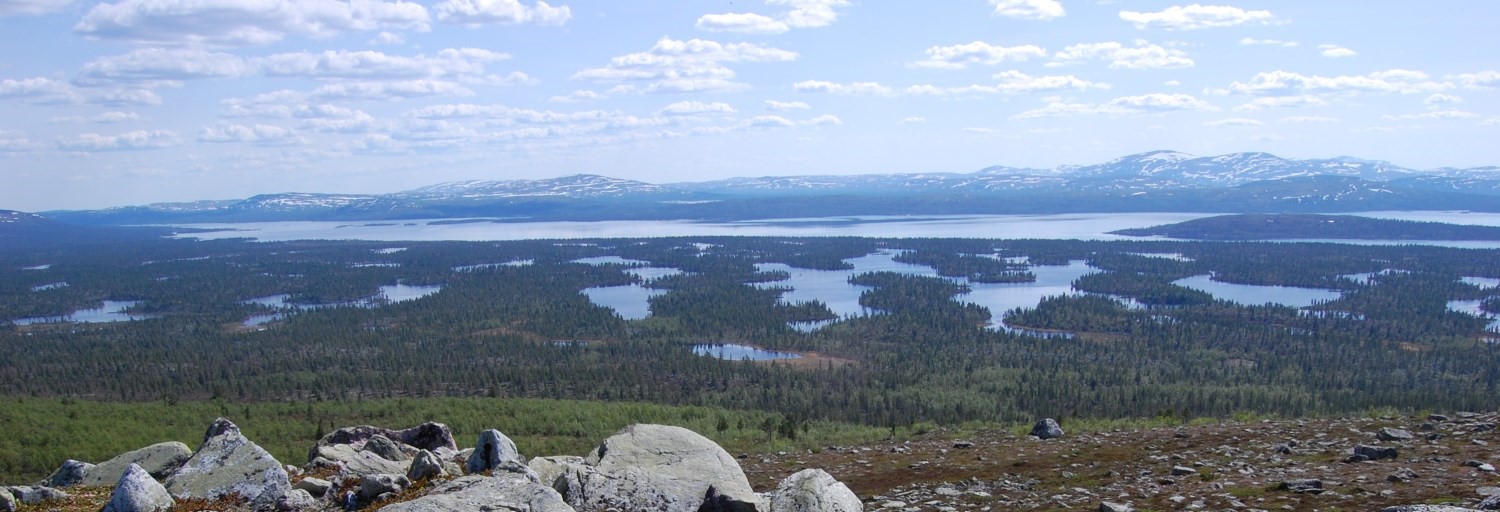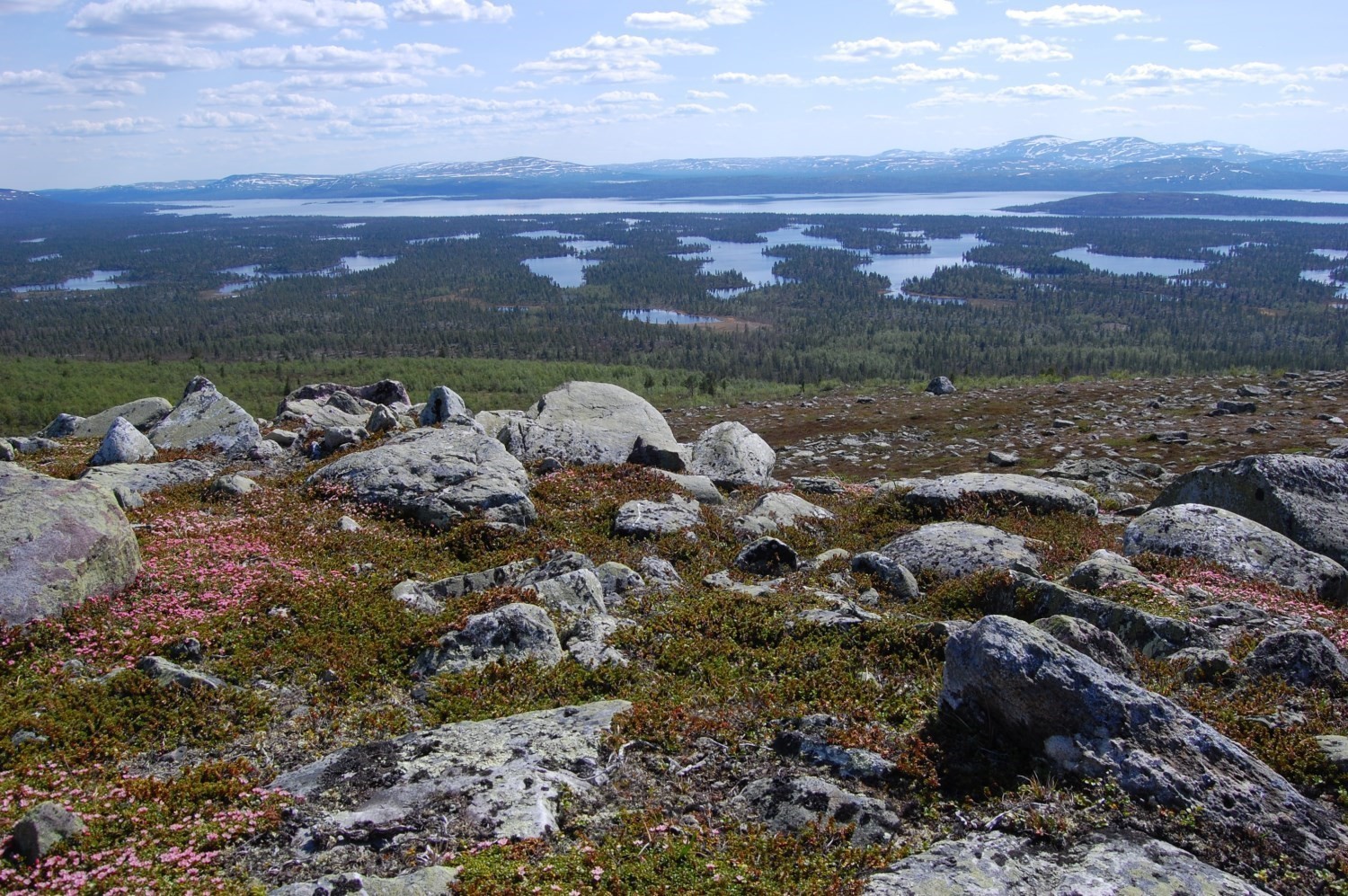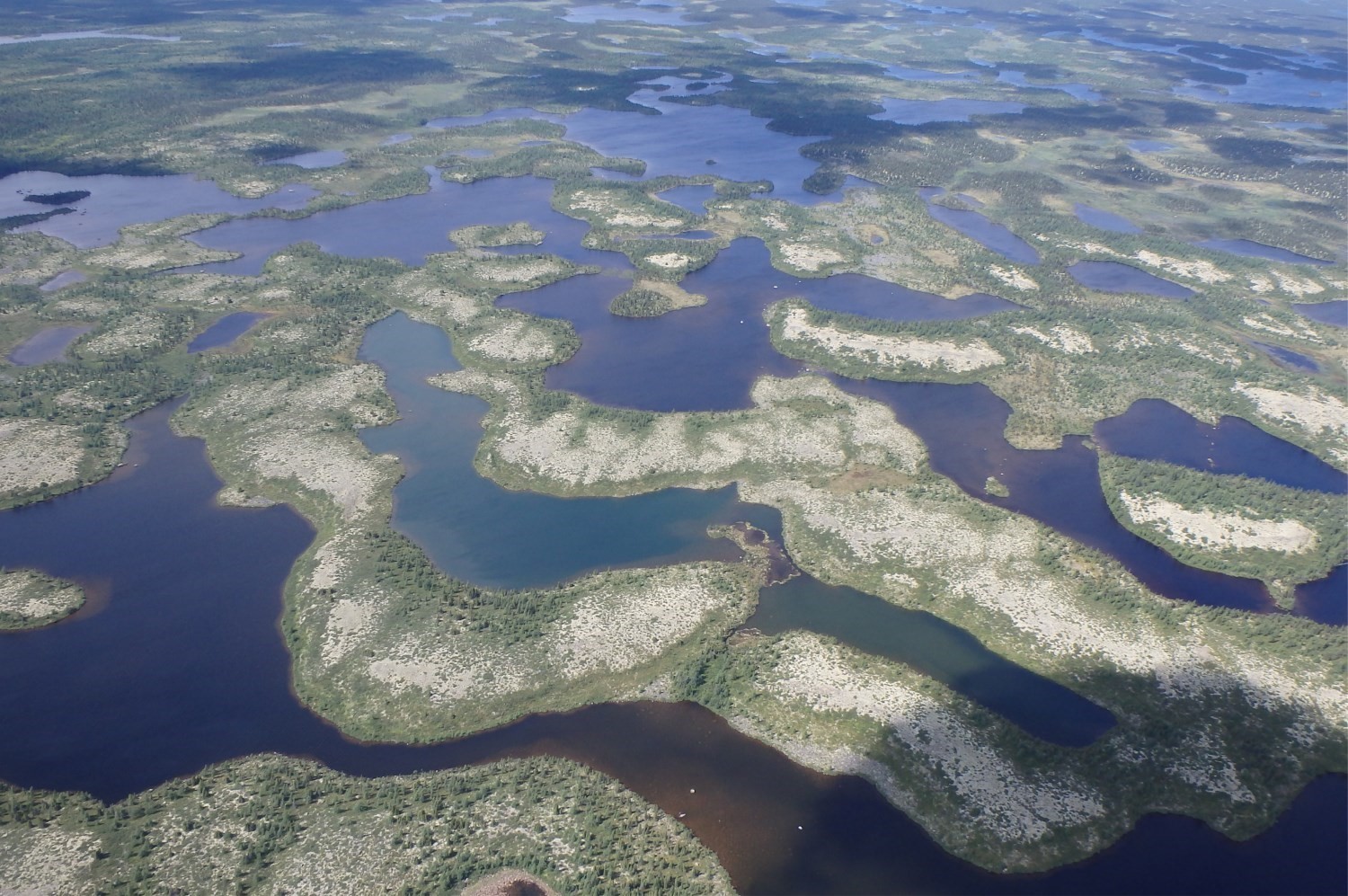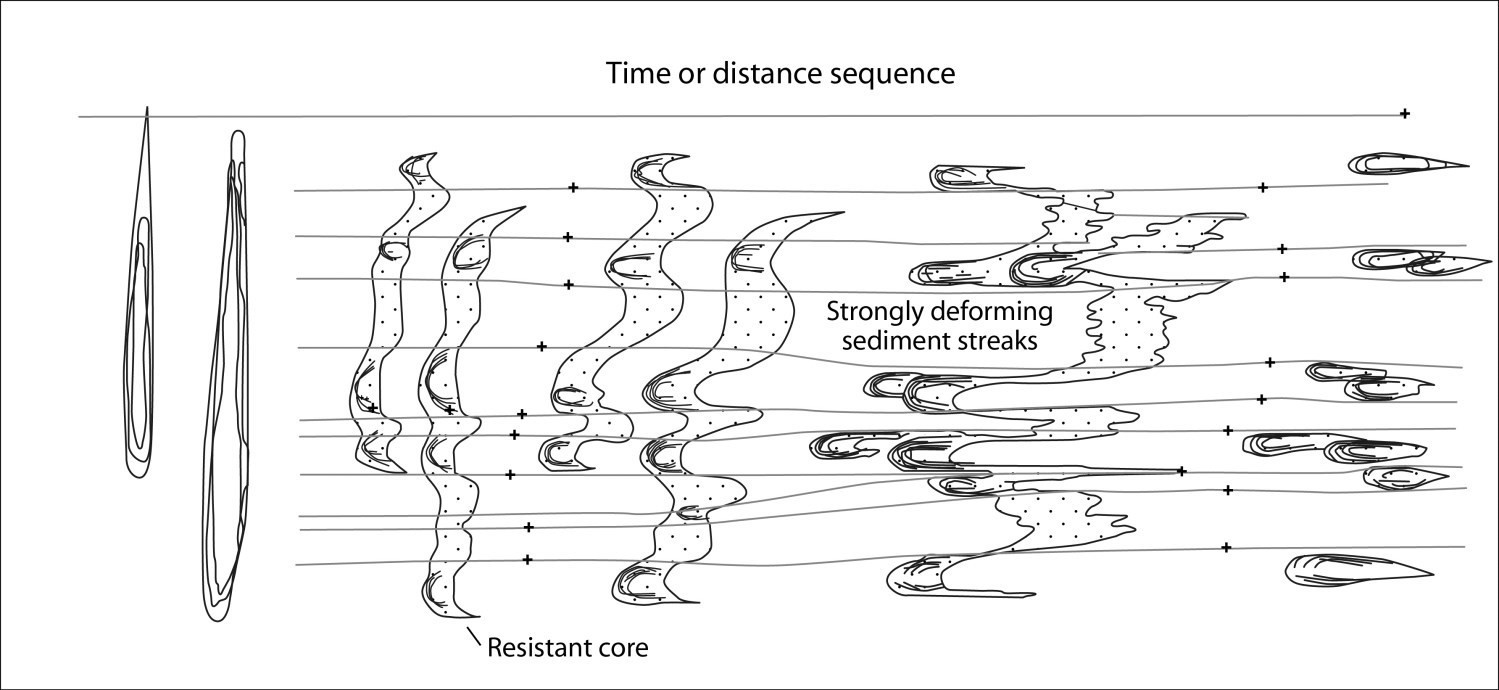
Last modification:
Etymology
Ribbed moraines are so named because they resemble the ribs of a rib cage. The name was popularized by Lee (1959) and Hughes (1964). The term “Rogen moraine” is also used, based on the typical example of Lake Rogen, Härjedalen, Sweden (Hoppe, 1959), where they were first described (Lundqvist, 1937; Mannerfelt, 1945; Hoppe, 1959). Historically, the two terms refer to slightly different moraines, but their use in recent Ministère literature is interchangeable. Initial observations of Rogen or ribbed moraines referred to a purely descriptive type of field morphology. Rogen moraine was then referred to as an area of undulating ridges; the term moraine being used in its lithological sense (Hughes, 1964; Bouchard, 1980; 1989; Benn and Evans, 2010).
Description

 Ribbed moraines are defined as undulating ridges with a boudinaged and possibly arched morphology. The main orientation of the ridges is perpendicular to the ice flow direction. Typical dimensions are 300 m to 1200 m long, 100 m to 300 m wide by 10 m to 40 m high (Hoppe, 1959; Lundqvist, 1969; Hättestrand and Kleman, 1999; Dunlop and Clark, 2006; Benn and Evans, 2010). There is an almost regular spacing between the moraines (Hättestrand and Kleman, 1999).
Ribbed moraines are defined as undulating ridges with a boudinaged and possibly arched morphology. The main orientation of the ridges is perpendicular to the ice flow direction. Typical dimensions are 300 m to 1200 m long, 100 m to 300 m wide by 10 m to 40 m high (Hoppe, 1959; Lundqvist, 1969; Hättestrand and Kleman, 1999; Dunlop and Clark, 2006; Benn and Evans, 2010). There is an almost regular spacing between the moraines (Hättestrand and Kleman, 1999).
Several studies report an asymmetrical ridge profile, with the downstream slope being steeper than the upstream one (Hoppe, 1959; Shilts, 1977; Boulton, 1987; Shilts et al., 1987; Aylsworth and Shilts, 1989). They are typically arc-shaped with the ends pointing down ice (Bouchard, 1986; 1989). Dunlop and Clark (2006) demonstrated that these characteristics are too restrictive and that ribbed moraines exist in many different forms.
Ribbed moraines are generally composed of a massive or laminated diamicton incorporating a large number of boulders, but gravel, sand and silt may also be present. Sedimentary facies generally display evidence of glaciotectonic deformation in the form of shear planes and folds (Shaw, 1979; Fisher and Shaw, 1992; Hättestrand, 1997). In this type of moraine, the till fabrics indicate a clast orientation transverse to ice flow (Lundqvist, 1937; Cowan, 1968).
Areas of ribbed moraine are generally spatially associated with areas of streamlined till (Prest, 1968; Sugden and John, 1976); the latter are characterized by drumlinoids oriented at right angles or strongly oblique to moraine ridges. A gradual transition zone between these areas is common and is characterized by ribbed moraines displaying a streamlined surface morphology (Prest, 1968; Lundqvist, 1969; 1989; Markgren and Lassila, 1980; Aylsworth and Shilts, 1989). Aylsworth and Shilts (1989) note that lateral transitions between moraine and drumlinoid areas are generally steeper than transitions up and down ice of a ribbed moraine field. Moraines with a transitional or combined morphology are those that were originally referred to as “Rogen” (Lundqvist, 1969).
Genesis
The genesis and mechanisms controlling the formation of ribbed moraines are still a matter of debate. Several studies suggest that their formation is associated with a single glacial event (Bouchard, 1989; Aylsworth and Shilts, 1989; Hättestrand, 1997; Hindmarsh, 1998a; 1998b; 1999) or fluvial event (Shaw, 1979; Fisher and Shaw, 1992), whereas some authors rather propose a polyphase formation (Boulton, 1987; Lundqvist, 1989; 1997; Möller, 2006; Sarala, 2006).
 The morphological superimpositions observed in transitional zones could suggest polyphase genesis in space and time between ribbed moraines and certain drumlinoids (Lundqvist, 1969; Bouchard, 1986). Boulton (1987) proposed that ribbed moraines are part of a morphological continuum of linear bedforms resulting from the evolution of a deformable bedrock at the glacial base. A change in the direction of ice flow could thus cause undulatory deformation of drumlins, drumlinoids or terminal moraines (Lundqvist, 1969; 1989; Boulton, 1987; Clark, 1994; Möller, 2006; Finlayson and Bradwell, 2008). This process cannot be the origin of all the observed bedforms and is probably not the only one responsible for the formation of ribbed moraines.
The morphological superimpositions observed in transitional zones could suggest polyphase genesis in space and time between ribbed moraines and certain drumlinoids (Lundqvist, 1969; Bouchard, 1986). Boulton (1987) proposed that ribbed moraines are part of a morphological continuum of linear bedforms resulting from the evolution of a deformable bedrock at the glacial base. A change in the direction of ice flow could thus cause undulatory deformation of drumlins, drumlinoids or terminal moraines (Lundqvist, 1969; 1989; Boulton, 1987; Clark, 1994; Möller, 2006; Finlayson and Bradwell, 2008). This process cannot be the origin of all the observed bedforms and is probably not the only one responsible for the formation of ribbed moraines.
 A second model explains their formation by compressive ice flow that causes shearing of the pre-existing sedimentary layer or generating a new basal accumulation of sediments (Lundqvist, 1969; Bouchard, 1986; Hättestrand, 1997; Hättestrand and Kleman, 1999; Sarala, 2006; Lindén et al., 2008). Debris embedded at the base of the ice would be superimposed in response to compression and shear during ice flow. This compression would occur in topographic depressions or at the boundary between a warm- and cold-based glacier (Sugden and John, 1976; Shaw, 1979; Sollid and Sorbel, 1984; Bouchard, 1986; 1989). In this model, the transition from drumlin forms to ribbed moraines is explained by a change in the flow regime from compressive to extensive.
A second model explains their formation by compressive ice flow that causes shearing of the pre-existing sedimentary layer or generating a new basal accumulation of sediments (Lundqvist, 1969; Bouchard, 1986; Hättestrand, 1997; Hättestrand and Kleman, 1999; Sarala, 2006; Lindén et al., 2008). Debris embedded at the base of the ice would be superimposed in response to compression and shear during ice flow. This compression would occur in topographic depressions or at the boundary between a warm- and cold-based glacier (Sugden and John, 1976; Shaw, 1979; Sollid and Sorbel, 1984; Bouchard, 1986; 1989). In this model, the transition from drumlin forms to ribbed moraines is explained by a change in the flow regime from compressive to extensive.
 Another theory explaining the genesis of ribbed moraines is that of fracturing and extension of pre-existing frozen sediment layers (Boulton, 1987; Lundqvist, 1989; Hättestrand, 1997; Hindmarsh, 1998a, 1998b, 1999; Hättestrand and Kleman, 1999; Sarala, 2006). During deglaciation, two layers of sediment are superimposed: a first, superficial layer is formed of frozen sediment; a second, underlying layer is unfrozen and deformable. The interface between these two layers would allow for the formation of a decollement plane, generating an extensive flow regime. The resulting shearing would fracture the frozen sediment layers, creating an interdigitated pattern.
Another theory explaining the genesis of ribbed moraines is that of fracturing and extension of pre-existing frozen sediment layers (Boulton, 1987; Lundqvist, 1989; Hättestrand, 1997; Hindmarsh, 1998a, 1998b, 1999; Hättestrand and Kleman, 1999; Sarala, 2006). During deglaciation, two layers of sediment are superimposed: a first, superficial layer is formed of frozen sediment; a second, underlying layer is unfrozen and deformable. The interface between these two layers would allow for the formation of a decollement plane, generating an extensive flow regime. The resulting shearing would fracture the frozen sediment layers, creating an interdigitated pattern.
The latter two formation types are consistent with the gradual transitions observed between the streamlined and morainal areas. The authors invoke only one flow direction, suggesting that drumlinoids and ribbed moraines are contemporaneous and caused by the same event.
Spatial Distribution
 The global spatial distribution of ribbed moraines corresponds to ice-covered areas of the Laurentide and Greenland inlandsis and the Fennoscandian and Anglo-Irish ice sheets (Hättestrand, 1997; Clark, 1999; Clark and Meehan, 2001) in Sweden, Finland, Ireland, Scotland, Canada and the USA (Lundqvist, 1981; Hättestrand and Kleman, 1999; Dunlop, 2004; Dunlop and Clark, 2006; Finlayson and Bradwell, 2008). Typically, ribbed moraines develop within 50 km to 350 km of glacial margins as the recessional margin approaches these areas (Shaw, 1979; Shilts et al., 1987; Bouchard, 1989; Kleman and Hättestrand, 1999).
The global spatial distribution of ribbed moraines corresponds to ice-covered areas of the Laurentide and Greenland inlandsis and the Fennoscandian and Anglo-Irish ice sheets (Hättestrand, 1997; Clark, 1999; Clark and Meehan, 2001) in Sweden, Finland, Ireland, Scotland, Canada and the USA (Lundqvist, 1981; Hättestrand and Kleman, 1999; Dunlop, 2004; Dunlop and Clark, 2006; Finlayson and Bradwell, 2008). Typically, ribbed moraines develop within 50 km to 350 km of glacial margins as the recessional margin approaches these areas (Shaw, 1979; Shilts et al., 1987; Bouchard, 1989; Kleman and Hättestrand, 1999).
References
Publications Available Through SIGÉOM Examine
BOUCHARD, M.A., 1986. Géologie des dépôts meubles de la région de Témiscamie (Territoire-du-Nouveau-Québec). Ministère de l’Énergie et des Ressources, Québec; MM 83-03, 90 pages.
Other Publications
AYLSWORTH, J.M., SHILTS, W.W., 1989. Bedforms of the Keewatin Ice Sheet, Canada. Sedimentary Geology; volume 62, pages 407-428. doi.org/10.1016/0037-0738(89)90129-2
BENN, D.I., EVANS, D.J.A., 2010. Glaciers and glaciations. Second edition. Routledge, Taylor & Francis Group, London and New York, 802 pages. https://doi.org/10.4324/9780203785010
BOUCHARD, M.A., 1980. Late Quaternary geology of the Temiscamie area, central Quebec. McGill University; Ph.D. Thesis, 284 pages. Source
BOUCHARD, M.A., 1989. Subglacial Landforms and Deposits in Central and Northern Québec, Canada, with Emphasis on Rogen Moraines. Sedimentary Geology; volume 62, pages 293-308. doi.org/10.1016/0037-0738(89)90120-6
BOULTON, G.S., 1987. A theory of drumlin formation by subglacial sediment. Drumlin Symposium. Rotterdam: Balkema.
CLARK, C.D., 1994. Large-scale ice-moulding: a discussion of genesis and glaciological significance. Sedimentary Geology; volume 91, pages 253-268. doi.org/10.1016/0037-0738(94)90133-3
CLARK, C.D., 1999. Glaciodynamic context of subglacial bedform generation and preservation. Annals of Glaciology; volume 28, pages 23-32. doi.org/10.3189/172756499781821832
CLARK, C.D., MEEHAN, R.T., 2001. Subglacial bedform geomorphology of the Irish Ice Sheet reveals major configuration changes during growth and decay. Journal of Quaternary Science; volume 16, pages 483-496. doi.org/10.1002/jqs.627
COWAN, W.R., 1968. Ribbed moraine: till-fabric analysis and origin. Canadian Journal of Earth Sciences; volume 5, pages 1145-1159. doi.org/10.1139/e68-112
DUNLOP, P., 2004. The characteristics of ribbed moraine and assessment of theories for their genesis. University of Sheffield; Doctoral thesis, 363 pages. Source
DUNLOP, P., CLARK, C.D., 2006. The morphological characteristics of ribbed moraine. Quaternary Science Reviews; volume 25, pages 1668-1691. doi.org/10.1016/j.quascirev.2006.01.002
FINLAYSON, A.G., BRADWELL, T., 2008. Morphological characteristics, formation and glaciological significance of Rogen moraine in northern Scotland. Geomorphology; volume 101, pages 607-617. doi.org/10.1016/j.geomorph.2008.02.013
FISHER, T.G., SHAW, J., 1992. A depositional model for Rogen moraine, with examples from the Avalon Peninsula, Newfoundland. Canadian Journal of Earth Sciences; volume 29, pages 669-686. doi.org/10.1139/e92-058
HÄTTESTRAND, C., KLEMAN, J., 1999. Ribbed moraine formation. Quaternary Science Reviews; volume 18, pages 43-61. doi.org/10.1016/S0277-3791(97)00094-2
HÄTTESTRAND, C., 1997. Ribbed moraines in Sweden – distribution pattern and palaeoglaciological implications. Sedimentary Geology; volume 111, pages 41-56. doi.org/10.1016/S0037-0738(97)00005-5
HINDMARSH, R.C.A., 1998a. Drumlinization and drumlin-forming instabilities: viscous till mechanisms. Journal of Glaciology; volume 44, pages 293-314. doi.org/10.3189/S002214300000263X
HINDMARSH, R.C.A., 1998b. The stability of a viscous till sheet coupled with ice flow, considered at wavelengths less than the ice thickness. Journal of Glaciology; volume 44, pages 285-292. doi.org/10.3189/S0022143000002628
HINDMARSH, R.C.A., 1999. Coupled ice–till dynamics and the seeding of drumlins and bedrock forms. Annals of Glaciology; volume 28, pages 221-230. doi.org/10.3189/172756499781821931
HOPPE, G., 1959. Glacial Morphology and Inland Ice Recession in Northern Sweden. Geografiska Annaler; volume 41, pages 193-212. doi.org/10.1080/20014422.1959.11907951
HUGHES, O.L., 1964. Surficial geology, Nichicun-Kaniapiskau map-area, Quebec. Geological Survey of Canada; Bulletin 106, 20 pages. doi.org/10.4095/100624
KLEMAN, J., HÄTTESTRAND, C., 1999. Frozen-bed Fennoscandian and Laurentide ice sheets during the Last Glacial Maximum. Nature; volume 402, pages 63-66. doi.org/10.1038/47005
LEE, H.A., 1959. Surficial geology of southern district of Keewatin and the Keewatin ice divide, Northwest Territories. Geological Survey of Canada; Bulletin 51, 42 pages. doi.org/10.4095/100573
LINDÉN, M., MÖLLER, P., ADRIELSSON, L., 2008. Ribbed moraine formed by subglacial folding, thrust stacking and lee-side cavity infill. Boreas; volume 37, pages 102-131. doi.org/10.1111/j.1502-3885.2007.00002.x
LUNDQVIST, G., 1937. Sjiisediment fran Rogenomriider i Harjedalen. Sveriges Geologiska Undersokning; Serie C, Nr. 408.
LUNDQVIST, J., 1969. Problems of the So-Called Rogen Moraine. Sveriges Geologiska Undersokning; volume 64, 32 pages.
LUNDQVIST, J., 1981. Moraine morphology. Terminological remarks and regional aspects. Geografiska Annaler; volume 63A, pages 127-138. doi.org/10.2307/520824
LUNDQVIST, J., 1989. Rogen (ribbed) moraine identification and possible origin. Sedimentary Geology; volume 62, pages 281-292. doi.org/10.1016/0037-0738(89)90119-X
LUNDQVIST, J., 1997. Rogen moraine–an example of two-step formation of glacial landscapes. Sedimentary Geology; volume 111, pages 27-40. doi.org/10.1016/S0037-0738(97)00004-3
MANNERFELT, C.M.S., 1945. Några Glacialmorfologiska Formelement: Och Deras Vittnesbörd Om Inlandsisens Avsmält-Ningsmekanik I Svensk Och Norsk Fjällterräng. Geografiska Annaler; volume 27, pages 3-5. doi.org/10.1080/20014422.1945.11880732
MARKGREN, M., LASSILA, M., 1980. Problems of moraine morphology: Rogen moraine and Blattnick moraine. Boreas; volume 9, pages 271-274. doi.org/10.1111/j.1502-3885.1980.tb00704.x
MÖLLER, P., 2006. Rogen moraine: an example of glacial reshaping of pre-existing landforms. Quaternary Science Reviews; volume 25, pages 362-389. doi.org/10.1016/j.quascirev.2005.01.011
PREST, V.K., 1968. Nomenclature of Moraines and Ice-Flow Features as Applied to the Glacial Map of Canada. Geological Survey of Canada; paper 67-57, 27 pages. doi.org/10.4095/106451
SARALA, P., 2006. Ribbed moraine stratigraphy and formation in southern Finnish Lapland. Journal of Quaternary Science; volume 21, pages 387-398. doi.org/10.1002/jqs.995
SHAW, J., 1979. Genesis of the Sveg Tills and Rogen Moraines of Central Sweden: A Model of Basal Melt Out. Boreas; volume 8, pages 409-426. doi.org/10.1111/j.1502-3885.1979.tb00437.x
SHILTS, W.W., AYLSWORTH, J.M., KASZYCKI, C.A., KLASSEN, R.A., 1987. Canadian Shield. In Geomorphic systems of North America: Boulder Colorado, Centennial Special Volume 2 (Graf, W.L., editor), Geological Society of America, pages 119-161.
SHILTS, W.W., 1977. Geochemistry of till in perennially frozen terrain of the Canadian Shield – Application to prospecting. Boreas; volume 6, pages 203-212. doi.org/10.1111/j.1502-3885.1977.tb00349.x
SOLLID, J.L., SØRBEL, L., 1984. Distribution and genesis of moraines in Central Norway. Striae; volume 20, pages 63-67.
SUGDEN, D.E., JOHN, B.S., 1976. Glaciers and Landscape. John Wiley & Sons, New York, 376 pages.
Contributors
First publication | Olivier Lamarche, P. Geo., M.Sc. olivier.lamarche@mern.gouv.qc.ca (redaction) Hugo Dubé-Loubert, P. Geo., Ph.D. hugo.dube-loubert@mern.gouv.qc.ca (critical review); François Leclerc, P. Geo., Ph.D. (template and content compliance); Simon Auclair, P. Geo., M.Sc. (editing); Céline Dupuis, P. Geo., Ph.D. (English version); Nathalie Bouchard (HTML editing). |
